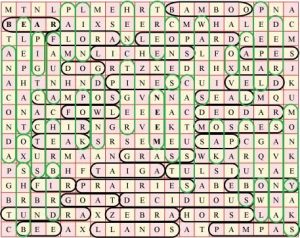6.2 Text Questions :
Answer the following questions :
1. Which are the two factors on which the growth of vegetation mostly depends ?
Ans: The two factors on which the growth of vegetation mostly depends are temperature and moisture .
2. Which are the three broad categories of natural vegetation ?
Ans: The three broad categories of natural vegetation are forests, grasslands and shrubs.
3. Name the two hardwood trees commonly found in tropical evergreen forest.
Ans: Rosewood and mahogany are the two hardwood trees commonly found in tropical forest.
4. In which part of the world are tropical deciduous forests found ?
Ans: Tropical deciduous forests are found in the large part of India, northern Australia and in central America.
5. In which climatic conditions are citrus fruits cultivated ?
Ans: Citrus fruits are cultivated in the regions marked for hot dry summers and mild rainy winters.
6. Mention the uses of coniferous forest.
Ans: The woods of coniferous forest are tall and soft. Fir, pine and cedar are the important variety of trees in these forests. The woods of these forests are very useful for making pulp, which is used for manufacturing paper and newsprint. Match boxes and packing boxes are also made from softwood.
7. In which part of the world is seasonal grassland found ?
Ans: Seasonal grasslands are found in the mid latitudinal zones and in the interior part of the continents.
Tick the correct answer :
1. Mosses and Lichens are found in ________ .
(a) Desert vegetation (b) Tropical evergreen forest (c) Tundra vegetation √ .
2. Thorny bushes are found in _________ .
(a) Hot and humid tropical climate (b) Hot and dry desert climate √ (c) Cold polar climate.
3. In tropical evergreen forest , one of the common animals is _________ .
(a) Monkey √ (b) Giraffe (c) Camel
4. One important variety of coniferous forest is __________ .
(a) Rosewood (b) Pine √ (c) Teak
5. Steppe grassland is found in ________ .
(a) South Africa (b) Australia (c) Central Asia √
Match the following :
1) Walrus (a) Soft wood tree.
2) Cedar (b) An animal of tropical deciduous forest.
3) Olives (c) A polar animal.
4) Elephants (d) Temperate grassland in Antarctica.
5) Campos (e) A citrus fruit.
6) Downs (f) Tropical grassland of Brazil.
Answers :
1) Walrus — (c) a polar animal.
2) Cedar — (a) soft wood tree.
3) Olives — (e) a citrus fruit.
4) Elephants — (b) an animal of tropical deciduous forest.
5) Campos — (f) tropical grassland of Brazil.
6) Downs — (d) temperate grassland in Antarctica.
Give reasons :
1. The animals in polar region have thick fur and thick skin.
Ans: The animals in polar region have thick fur and thick skin to protect themselves from the cold climatic conditions.
2. Tropical deciduous trees shed their leaves in the dry season
Ans: Tropical deciduous trees shed their leaves in the dry season to conserve water as the process of evaporation takes place from the leaves.
3. The type and thickness of vegetation changes from place to place.
Ans: The type and thickness of vegetation changes from place to place because of the variation in temperature and moisture..
Activity to be done by students themselves :
For Fun :
In the crossword table given below, some words are hidden. They are all about vegetation and wildlife and are to be found horizontally and vertically. Two have been worked out for you. Work in pairs with a friend.

Vegetation Wildlife :
1. Neem 2. Bear 3. Bamboo 4. Whale
5. Flora 6. Ox 7. Lichen 8. Zebra
9. Pine 10. Goat. 11. Chir 12. Tiger
13. Grass 14. Yak 15. Taiga 16. Owl
17. Tulsi 18. Deer 19. Fir 20. Lion
21. Tundra 22. Fowl 23. Ebony 24. Horse
25. Pampas 26. Pig 27. Llanos 28. Camel.
29. Deciduous 30. Leopard 31. Prairies 32. Monkey
33. Deodar 34. Anaconda 35. Campos 36. Teak 37. Mosses .

